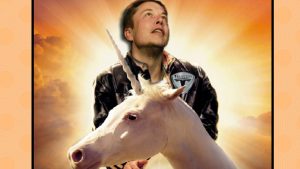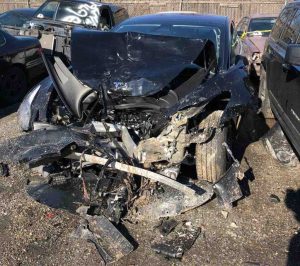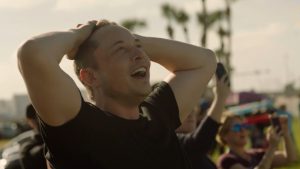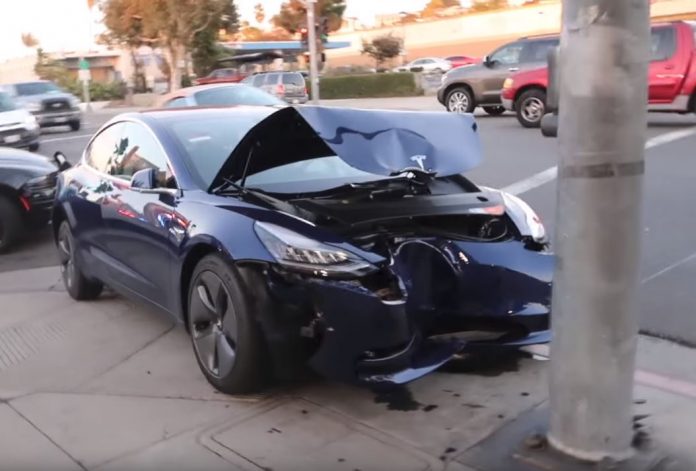At Tesla, wishes are the same as facts. So when Tesla wishes the Model 3 to be the “safest car ever built” then it must be so.
Except NHTSA – the federal saaaaaaaaaaaaaaaaafety regulatory agency which rates the saaaaaaaaaaaaaaafety of new cars – takes exception to Tesla’s claims.
The feather-ruffle began over the weekend, when Tesla let loose a lengthy blog post claiming that it had engineered the Model 3 to “be the safest car ever built” and that NHTSA’s tests show that it has “the lowest probability of injury of all cars the safety agency has ever tested.”
But in a statement released on Tuesday, NHTSA disputed Tesla’s claims.
“A 5-Star rating is the highest safety rating a vehicle can achieve,” the agency said in the statement. And then: “NHTSA does not distinguish safety performance beyond that rating, thus there is no ‘safest’ vehicle among those vehicles achieving 5-Star ratings.”
What this means in plain English is that a given car’s star ranking is awarded within its class and relative to other cars within that class. A compact-sized car that receives a 5 Star ranking is “safer” (all this means is it scores higher on various crash tests, not that it is more or less likely to crash) than a compact-sized car that receives a 4 Star ranking .
It does not mean the 5 Star compact is as “safe” as a 5 Star full-size car . . . or even a 4 Star one.
Size does matter when it comes to occupant protection – a fact which NHTSA does not clearly explain to people and which Tesla is trying to exploit via its “safest car ever” flim-flam.
The Model 3 received 5 Star ratings in frontal and side crash tests, rollover prevention and overall. The 2018 Honda Accord, Subaru Legacy and Toyota Camry also scored 5 Stars in those categories – and all of them are mid-sized cars.
They are not as “safe” as full-size cars with the same 5 Star ranking. Take an S-Class Mercedes and a Model 3 – both of them 5 Star awardees – and let them collide at 40 MPH and this fact will become extremely obvious.
NHTSA warned Tesla that using terms such as “safest” and “perfect” to describe a particular rating or an overall score are misleading.
Certainly. But it ought to apply the same brush strokes to itself as much as Tesla. The “star” ranking system is hugely deceptive because most people have no idea that these rankings are not general. They assume that a 5-Star ranked little car is just as “safe” as a 5 Star-ranked full-size car.
It’s not.
And, while we’re at it, how about the the heightened fire risk of electric cars – all of them, not just Teslas? Shouldn’t be taken into consideration with regard to these saaaaaaaaaaaafety rankings?
Gas-engined cars can catch fire, too – but they are less likely to catch fire, for two reasons:
First, there must be a gas leak. Denting or otherwise damaging the tank will not cause a fire or even increase the risk of a fire – unless the tank is dented enough to leak. You can hit a gas tank with a sledgehammer and not risk a fire merely by bashing up the tank. The fuel sloshes around, that’s all.
There must also be an ignition source, such as a spark, to light the fire. Gas by itself will not burn. 
Gasoline can splash all over the road – and so long as there’s no spark, there’s no worry.
And the gas probably won’t spill unless the car is hit in a very specific way in a very specific place – the place where its gas tank is located, which is usually in the rear of the car. A frontal impact may crush the nose, but it won’t crush the fuel tank – because it’s not there.
With electric cars, the risk of fire is greater for two reasons:
First, the battery pack is vulnerable to damage from almost any impact angle, frontal, rear or side – because it is spread out over the entire length of the car.
Second, if the battery case is damaged, the risk of fire is very high because inside the battery are materials which will spontaneously combust if they come into contact.
No outside ignition source is needed. These fires can get extremely hot, extremely quickly and they are much harder to snuff than a gas fire. Some Teslas which have caught fire and been “put out” lit themselves back on fire the next day.
It’s interesting that NHTSA isn’t issuing an statements about that.
. . .
Got a question about cars – or anything else? Click on the “ask Eric” link and send ’em in!
If you like what you’ve found here please consider supporting EPautos.
We depend on you to keep the wheels turning!
Our donate button ishere.
If you prefer not to use PayPal, our mailing address is:
EPautos
721 Hummingbird Lane SE
Copper Hill, VA 24079
PS: Get an EPautos magnet (pictured below) in return for a $20 or more one-time donation or a $5 or more monthly recurring donation. (Please be sure to tell us you want a sticker – and also, provide an address, so we know where to mail the thing!)
My latest eBook is also available for your favorite price – free! Click here. 












Life is a nightmare now.
You’ll be wiretapped if you make a phone call and tracked by license plate readers if you drive.
If you go to a baseball game or Disneyland, you’ll need to give your fingerprints, be molested, and be made to carry a microchip.
We’re all slaves living in a prison.
Who would want to be born into this world?
Americans are no better than Nazis now.
The world has turned upside down now. All the rules have changed.
Clean-cut, moral Americans who were taught to love peace, hate debt, oppose Communism, be hard-working, be responsible, respect free speech, support religious freedom, defend gun rights, oppose warrantless searches, seizures, and torture must be in a state of shock to watch the USA become Socialist.
Life is meaningless now that everything is illegal, hard work is punished with taxes and regulations, laziness is rewarded with welfare, the USA has become a ghetto overrun with 3rd world immigrants, and the US is an immoral bankrupt warmongering police state.
The collapse of the USA is disgusting and shameful.
Hi Libertarian,
Please refrain from reposting the same post – with a link to your site – over and over and over. We welcome your thoughts and hope you’ll contribute, but please don’t use the posting area as free advertising space for your web site.
We’re not slaves. We’re livestock and this is a giant human farm.
“They are not as “safe” as full-size cars with the same 5 Star ranking. Take an S-Class Mercedes and a Model 3 – both of them 5 Star awardees – and let them collide at 40 MPH and this fact will become extremely obvious.” When I checked NHSTA website I could not find ratings for anything but Tesla. I am not sure why. Maybe I am doing it wrong.
I checked the NHSTA web site:
Tesla 5 star rating: https://www.nhtsa.gov/vehicle/2018/TESLA/MODEL%2525203/4%252520DR/RWD
2011 MERCEDES-BENZ S-CLASS is unrated, I could not find any more recent entries.
https://www.nhtsa.gov/vehicle/2011/MERCEDES-BENZ/S-CLASS/4%252520DR/RWD
The web page dealing with Tesla had some technical reports that might give more info about the tests and results.
Hi George,
There is a lot of disingenuousness to parse here. First, Tesla’s. The Model 3 is “by the numbers” (length, wheelbase, etc.) a compact sedan and should be compared with other compact sedans. The Model S is a mid-sized sedan by the numbers and should be compared with other mid-sized sedans.
The Mercedes S is a full-size sedan; there is no direct Tesla comparison.
Keep in mind, also, that these “safety” scores are just measures of how well a car does in a government crash test. It does not mean a given car is more likely to crash.
Arguably, one could make a solid case that a small/light an agile car with excellent outward visibility and quick steering is inherently safer – in terms of being less likely to crash – than a lumbering lummox government saaaaaaaaaaaaaaafety car.
Amazing how Elon gets away with so much false self-promotion and hype. And it’s interesting that there is one other fuel type that is even less combustible than gasoline: Diesel fuel.
Sickening how the powers that be want to force us into vehicles that are progressively more dangerous in relation to their fuel source of choice.
This idea of a safe car being one where there is low injury in a crash I have a fundamental problem with. The safest car is the one that does not crash. So this is just crash safety. It has nothing to do with how safe the car is overall.
Gasoline tanks require a three fold failure. One, the tank must leak. Two there must be sufficient fuel vapors for ignition, three there must be an ignition source. Li Ion batteries? There must be a short. That’s it. The case of the battery back shell need not even be broken. The short could be inside of it or outside of it. Now ideally they put protection in such that an external short means that power is cut from inside the pack, but did they?
Tesla seems to be really good at engineering the big stuff, like crash protection. The benefit of having hired some talented people and offering them the chance to do a clean-sheet design with minimal bureaucratic overhead.
But they’re not so good at the small details that also matter, like panel fit, having spare parts available for repairs, and getting production numbers up. Stuff that traditional car makers figured out long ago.
In the weird world of potential lawsuits over false advertising, “safest” means less safe than “safer”. If Musk claims the Tesla 3 is the “safest car ever built” based solely on the NHTSA’s 5 star rating, it is technically correct, in that ANY car ever built that ever got a 5 star rating is considered equal to any other 5 star rated car — in the NHTSA’s eyes. Though not in the real world.
If Elon had said that the Tesla 3 was “safer” than any other car ever built based on that rating, he’d get hauled into court and lose, because that would mean the 3 got a rating of 6 or above, higher than any of the 5 star cars.
In general, in advertising the “-er” claim is much stronger than the “-est” claim, which is why no one with a functioning legal department makes it.
I guess it needs to be safe in a crash if it is constantly trying to kill you while your using the suicide pilot.
And if you crash it in the wrong way it burns up and kills everyone inside so no need to worry about people testifying against you.
Pretty brilliant liability model if you think about it. Maimed for life people cost alot more than dead people in lawsuits.
If only they could kill all of the witnesses to their crashes as well noone would be left to refute their safety claims!
And not only that, plenty of those dead people knew the risk of burning and were happy to accept it for the privilege of being seen in such a hip ride! If they could, their ghosts would thank Tesla..
https://m.youtube.com/watch?v=rfwz3pHuJdE
Good point.
I listened to the elon musk interview on the joe rogan podcast and was pretty disturbed that they were gushing over the performance over the traction control and how you shouldnt trust your family in any other vehicle on potentially slick surfaces….
Im sitting there like “um ice is ice and if that tesla rear ends someone or gets rear ended by someone else, your entire family might be turned to dust in seconds”.
My profession is engineering and to sell something by omitting obvious safety flaws is gross neglegence. If I willfully did that and it lead to someones death i would be personally liable.
Yet elon can omit anything he wants and people die and everyone cheers!?
Worse yet he is covered for by many in the regulatory bodies.
I watched the Sandy Munro teardown of the Tesla. Tesla does not have an IC engine which means if it is in an accident passengers cannot be sandwiched behind the IC engine. The extremely heavy ‘skateboard’ means most of the mass of the car is beneath your feet. That is why EVs are safer than similar IC cars.
“if the Tesla crashed into my 5,300 lbs ” Mx Internet says, 2018 Tesla Model 3/Curb weight 3,838 to 4,072 lbs. Add 1000-1500lbs to get you to the weight of premium models. Tesla’s are heavy due to the battery pack and to a lesser extent, according to Mr Munro, poor design. Exactly who would win in a head-on collision would depend on who got squished my your IC engine.
You’d have to crash really hard to get crushed by the engine being pushed into the passenger’s zone, due to crumple zones. At that impact speed and G forces, if avoiding getting sandwiched didn’t kill you, something else likely would.
The more sheetmetal between you and trouble, the more energy from a collision can get soaked up. Air bags and whatnot are a poor substitute for sheer mass.
He is also conveniently forgetting that many (if not most at this point) IC cars have been designed so that in a severe crash the engine drops underneath the passenger compartment.
I’ve found in general that electric car fanboys (particularly Tesla/Musk fanboys) have a pretty poor grip on reality.
At the risk of being pedantic liquid gasoline splashed on the road will not burn, even with a spark. Only gasoline vapour mixed with the right proportion of air will ignite with a spark. A question, when crash testing an electric car, is the battery fully charged? It should be to give accurate real life results.
I think the fire issue with Tesla and other EVs is objects hitting the ‘skateboard’ from below. The actual battery pack is very low to the ground, so it might not be compromised in a catastrophic accident. The battery also seems to be composed of 7500 or more discrete batteries, so there is a firewall between each battery. There seems to be few fires affecting EVs. Tesla has had some issues, but Tesla can be operated like a sports car and there are a surprisingly large number of them, probably over 200,000 at this point so you would expect some bad luck. There are also a 100,000 or more Bolts. So the fire issue does not seem to be a huge problem.
George,
You miss the point – which is the double standard at work. If IC cars had a similar vulnerability, there would be an eructation of wailing – and recalling – issuing from DC.
But EVs are given a pass because they are EVs … and the government is working overtime to force-feed EVs to us.
It’s of a piece with the Takata airbag fiasco. A known deadly defect is allowed to remain in circulation… meanwhile, observe what happened to VW over its “cheating,” which harmed not a single living soul.
Hey Eric, speaking of the VW fiasco, Netflix has a series called “Dirty Money”. The first episode is about VW TDI’s, and it stars a few Clovers. Not sure if you heard about it. The producer, of course, makes out the TDI to be a destroyer the cleanliness of the earth’s atmosphere.
Hi Rush,
Yes, I’ve heard about it… haven’t had the heart to watch it yet.
Guessing if the risks of the batteries of an electric was considered, it wouldn’t get the five star rating. Probably no electric car would. So it never will be considered.
I have not seen an analysis of Tesla fire risk. If I have it right, the flammable material is actually in 18650 battery (sort of like a AAA) form. So each of the 7500 or more batteries has to explode individually. I don’t think it forms a cloud of flammable vapor and explodes like gas. Diesel is much safer than gas. But I would like to see an analysis of fires in a Tesla vs IC gas vehicle vs IC Diesel. FWIW Toyota is still developing a hydrogen car, so Toyota might come from behind to win the EV race.
The 18650 cell is between a AA and C in size. What happens is thermal run away and once one cell goes those next to it do and then the ones next to them and so on. The cells become hot from overcharging or shorting (sudden discharge).
OK, but thousands of discreet batteries lighting up one at a time seems like less of a problem than a single gas tank being compromised.
George,
The point – which you’ve missed – is that a gas tank can be “compromised” without a fire happening. A gas spill is no big deal unless someone lights a match (and the gas is vaporized enough to light off).
As Brent observed earlier, an EV battery is whole ‘nother thing. A short circuit, the case being damaged can easily lead to a fire and almost always will. No spark – as such – necessary.
Back to the earlier main issue – which you shied away from dealing with.
If EVs are so fantastic, why is it necessary to force them onto the market and prop them up with subsidies and other special treatment?
A compromised gasoline tank require the proper conditions to ignite. There has to be gasoline vapor and ignition. It’s a three layer failure. Now if you do like Ford and put in a fuel pump cut off switch then there’s a fourth layer in certain circumstances.
Once one cell ignites in a battery pack they will all ignite in turn. Battery Management systems work to prevent this. That’s why a whole pack can be rendered ‘bad’ by one or relatively few cells being dead. The BMS is set up to prevent fires and thus rejects charging. Now if a BMS is more advanced the pack can be less crippled by a dead cell but it will still prevent that section of the pack from charging to prevent fire.
I have had the experience of puncturing a lithium battery accidentally while servicing a home security system. The fire is instantaneous, extremely hot and difficult to extinguish. It burned a black spot in a wooden floor in seconds, after melting through its housing. That battery was smaller than a cigarette pack and only about 7 volts. You seriously underestimate the fire hazard involved with a battery capable of running a car.
Also these batteries are interconnected in series/parallel in order to create the voltage and current capability.
Lithium cells are the most volatile if you over discharge or over charge them, they have a nasty habit of coming unglued.
I’m an R/C flyer and have been flying electric for nearly 15 years. When Lithium cells came out or Lipos as we call them, there were no chargers available at the time to properly and safely charge them. They had to be monitored very closely to make sure nothing untoward happened.
Unfortunately, for some it was a disaster.garages, cars and even homes went up when the cells were inadvertently over charged.
Today’s chargers are very sophisticated with the capability to not only charge safely but to monitor the charge in each cell, called balance charging. The ones I use can also monitor the internal resistance of each cell.
The power of these battery packs has increased to such an extent that even large scale model planes can be safely flown without problems.
Those chinese made ‘hoverboards’ that caught fire. Someone at my company bought one. We took it apart in the lab. First, cheap prismatic Li-Ion cells. Second, a dumb charger. No taper current. It’s just fed constant voltage and current to the pack. Leave that on too long and the result is fire.
I have a feeling that if the Tesla crashed into my 5,300 lbs of steel (’76 Lincoln Mark IV), it would not fare so well as my car would. I would probably be scraping its residue off my bumper, wondering what the car used to be. Although, if I do not get the strong gas smell problem resolved, which I currently have, I may suffer the fate of many Tesla owners.